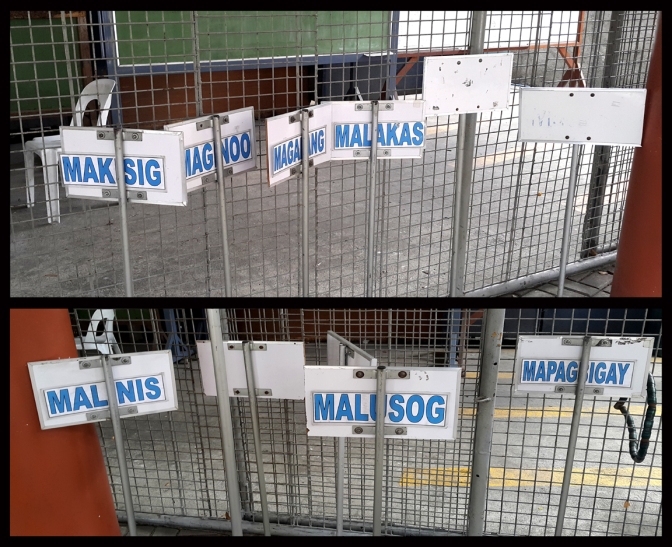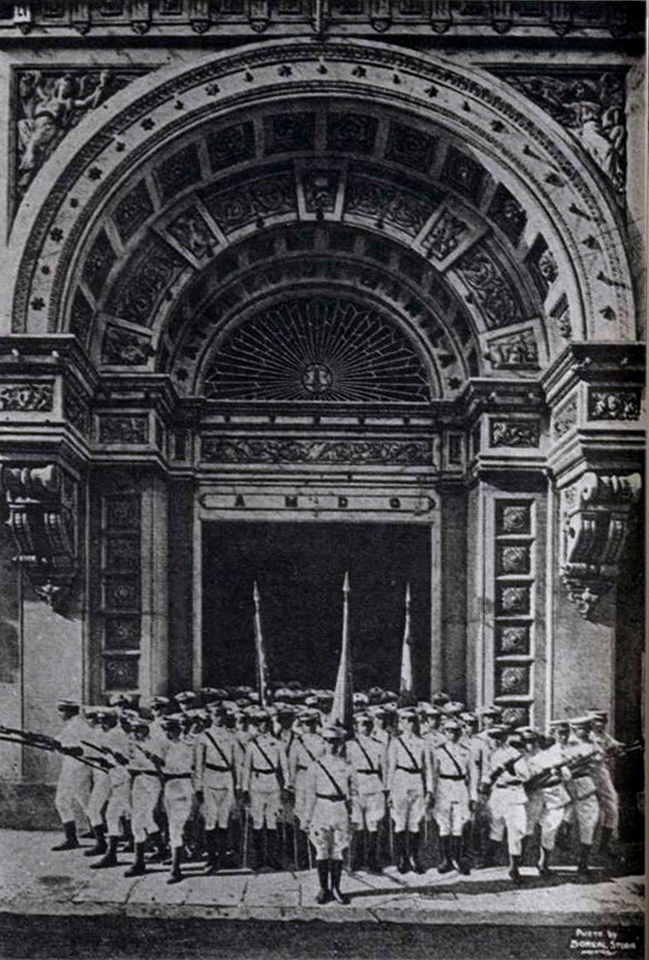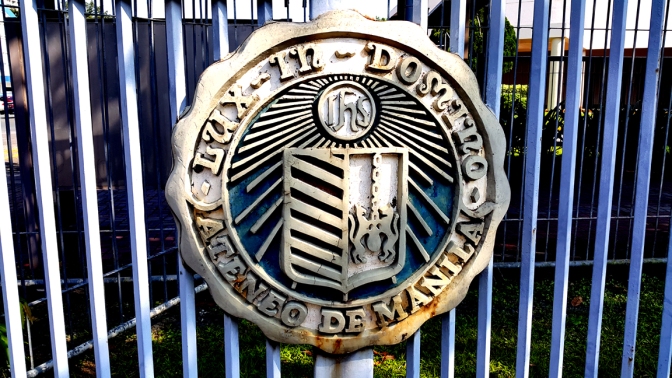In 1974, my parents enrolled me in the Ateneo de Manila Grades School in the preparatory program, or PREP for short. The Ateneo is a Catholic university; run by the Society of Jesus (Jesuits). Basically the Ateneo is an exclusive all-boys school, with the exception of the college, which became co-educational in the 1970s.

The clan Olivares has always been associated with the Ateneo de Manila, with almost every boy studying there at least up to high school, and many of the girls entering in college. Even in hard times, such as the aftermath of World War II, my grandparents continued to persevere in putting my father and his brothers in the Ateneo, knowing that the quality of education will help them in building their respective futures.

The Ateneo de Manila was founded in 1859, when the Jesuits took over the Escuela Municipal (Municipal School) in the walled city of Manila (Intramuros), during the Spanish occupation of the Philippines. Later it changed its name to Ateneo Municipal de Manila, which took its name from the Greek goddess of wisdom, Athena. The Intramuros campus burned down in 1932, so the Ateneo was moved to the San Jose Seminary along Padre Faura Street, in the Ermita District of Manila.

The Ateneo campus was razed by the bombing of Manila during World War II. Although the school reopened in 1946, there was a decision to transfer to the Ateneo to the newly acquired lands in Marikina. This area was later annexed to the newly formed Quezon City, and the new campus area was called Loyola Heights, which was named after the founder of the Society of Jesus, Saint Ignatius of Loyola (1491-1556). The campus was situated on the hills overlooking the Marikina Valley; hence the word “Heights” was added to the name.
Before entering the AGS (Ateneo Grade School) for the first time as a student, I had been there several times before, as I would accompany my parents when they would visit my brother (and other cousins) for family school events. But now it was my turn to be an Atenean.

The word Atenean was used to describe a student of the Ateneo, whereas a “Spanish-ized” version of the word would be Atenista. Our school colors were an ultramarine blue and white, which symbolized the Atenean’s devotion to Maria Purissima (Our Lady of the Immaculate Concepcion). Thus person who attended school in the Ateneo from grade school to high school is called a “True Blue Atenean”.

Entering the AGS’ iron gates, one is immediately confronted with two large cast-bronze seal of the Ateneo, with the Latin motto “Lux in Domino” written on it. Translated as “Light in the Lord”, this was meant to remind the student to always think and act in the light of Jesus Christ.

At the top of the gate posts are two concrete eagles, which represent the school mascot: The Blue Eagle.

Passing through the gates, one is greeted by Florante “Boy” Caedo’s 1960s sculpture of the Holy Family, in the middle of the driveway rotunda. The Caedo family has always been a favorite of the Jesuits, as they have been commissioned to create many of the old sculptures found throughout the campus. Florante’s father, Anastacio Caedo, worked side-by-side with the architects who developed the post-war campus. As for me, my friends and I would always run up to this sculpture during dismissal as sit Mary’s lap (or sit of Joseph’s shoulders) as we would discuss whatever fancied us at that time.
Anastacio Tanchauco Caedo (1907-1990) graduated from U.P. School of Fine Arts; under the tutelage of National Artist, Guillermo E. Tolentino. During his apprenticeship under Tolentino, the two took to body building as a means to understand the human anataomy and strengthen their bodies for he very physical work of sculpture. This love for body building led Tolentino to fashion his opus “The Oblation” after Caedo’s physique. Later Caedo made name for himself by sculpting many religious works for the Jesuits at the Ateneo de Manila and busts of the National Hero Dr. José Rizal for many of the Philippine Embassies around the world. Caedo was nominated three times as a National Artist of the Philippines (in 1983, 1984, and 1986); which he turned down, to avoid the politics in the art world.

Past the rotunda is the AGS entrance and Administrative Office, with the façade featuring Anastacio Caedo’s 1954 bas-relief of Jesus and the Children. The sculpture shows different types of children (girls and boys, infants to pre-teeners) with a few boys in the Ateneo school uniform. In the background is the AGS Chapel. Anastacio Caedo was one of the foremost classicist sculptors, who started his career during the American Occupation of the Philippines (1898-1946). He was nominated four times as National Artist for Sculpture, but he decided the honor each time.

At the right end of the AGS entrance, is the former PREP area. The most significant features of the place are the many tubular concrete playsets, with a nearby steel pipe climbing set, jungle gyms and a 15 ft (4.572 meters) high metal slide. Our favorite piece was the yellow tubular playset, which we dubbed the “Yellow Submarine” after the Beatles’ song/album/animated film. The jungle gyms and slide were later torn down, but when the AGS administration decided to tear down the concrete tubular sets many of the Ateneo alumni protested, and they have been kept there ever since.
All the first structures of the AGS were designed by Architect Gines Rivera, including the Administrative Office. Looking at it now, there are very little changes since the time I was a student, especially the glass blocks used on the Cashier’s office.

However, a recent addition to the interiors to the Administrative Office is Luis Ac-Ac’s wooden sculpture of Saint Ignatius de Loyola. It apparently replaced a stuffed eagle that was on display during my time. Ac-ac is a noted sculptor, from the town of Paete, Laguna province.
Luisito Ac-Ac (born 1952) is first and foremost a product of the carving town of Paete, Laguna Province. Ac-ac took his further studies at the University of the Philippines, College of Fine Arts, to major in Visual Communication. Ac-ac also minored in sculpture, where he apprenticed under fellow Pateño, Froilan Madriñan, and National Artists, Napoleon Abueva. Upon graduating, Ac-Ac worked as an illustrator at the Bookman Printing and Kayumanggi Press and El Dorado Comics of Graphic and Atlas. He later returned to his home town, and has been practicing wood carving hence.

Entering into the AGS campus area, to the right is the ACT (Ateneo Children’s Theater), whose name has been changed to the Mariano S. Singson, Jr. Hall in 2008. The structure was built in early 1950s as a multipurpose hall for sports events, meetings, and theatrical presentations of the ACT. It was renamed after our teacher Mr. Singson, who served the Ateneo as a teach and administrator from 1966 to 2000, with his special role as moderator and director of the Ateneo Children’s Theater.
Moving further down the campus hill, there rising among the old acacia trees is the Chapel of the Holy Guardian Angels. Built in 1954, the chapel was also designed by Arch. Gines Rivera. The stained glass windows and the wooden angels were a latter addition made during the renovations in the late 1990s.

At the altar of the chapel, there is a Art Deco inspired bas-relief of the Guardian Angels, which is attributed to the sculptor Anastacio Caedo.

At the side of the chapel is a figure of the Crucified Christ, which is attributed to Graciano Nepomuceno. Graciano is another classicist sculptor who started his career during the American Occupation of the Philippines. When I was a student, the chapel was not as well lit as it is now, so seeing this statue would freak me out then.
Graciano T. Nepomuceno (1881-1974) was a noted classical sculptor, who made his niche during the American Occupation. Nepomuceno studied painting under Miguel Zaragoza y Aranquizna (1847- 1923) at Liceo Filipino, and sculpture under prize-winning sculptor Ciriaco Arevalo. Aside from beautiful symbolical wooden sculptures, he is also known for creating the decorative panels at the Malacañang Palace and the façade of Metropolitan Theater. Nepomuceno is also known for his intricately sculpted santos (saints).

Behind the chapel is the Holy Guardian Angels Park, which was recently developed in 2010. At the center of the park is a 1954 statue of a Guardian Angel with an Ateneo Student, which might most likely be another creation of Anastacio Caedo.

At the front of the chapel is the flagpole, which as restored in 1992, for mass gatherings for the Flag Ceremony. Before the flagpole was outside the Administrative Office, so all students would just stand outside their respective classrooms and sing the “Lupang Hinirang” (“Land of the Chosen” / National Anthem) and recite the “Panatang Makabayan” (Pledge of Allegiance).

Beside the flagpole is Jose ‘Al’ Giroy’s 2001 statue of Saint Ignatius de Loyola. Íñigo López de Loyola was a Basque nobleman and soldier, who was retired from military life due to an injury in the Battle of Pamplona (1521). After receiving a vision of Christ, he turns his life around to become a holy man, and he forms the Society of Jesus. Thus the most recognized images of Saint Ignatius is when he offers his sword to God, to become a “Soldier of Christ”.
Jose “Al” Rabino Giroy (1962) is a noted sculptor, who started his career by participating in art competitions as a teen, in the 1970s. Eventually entering the University of the Philippines (U.P.) College of Fine Arts, Giroy would first delve into painting, before finally deciding to take sculpture and train under noted artists such as Froilan T. Madriñan Jr. (1941-2008) and National Artist for Sculpture, Napoleón Isabelo “Billy” Veloso Abueva (born 1930). After graduating, Grioy had participated group exhibitions, but soon focused on commissions for public art. A master of the classical sculptural created many noted monuments for government and private institutions, including churches; which are found all over the country.

Further on are the Intramural Courts, where we would play basketball. Around the courts and other points in the campus are Mosaic Tables, which were designed by Architect Vincent Pinpin, with the help of AGS students.

At one side of the Intramural Courts is Anastacio Caedo’s 1950s sculpture of the Immaculate Concepcion, which was based on a Hummel figurine.

At another end of the Intramural Courts is a figure of the Sacred Heart of Jesus, which might be a cast from a santero (saint sculptor). This was added in the late 1990s.

There are two entrances to the AGS campus, with the first coming from the side of the Administration Office, and the second coming from the side of the AGS Canteen. From the canteen, the first thing you notice is the AGS Swimming Pool. When we were students, our P.E. (Physical Education) instructor for swimming was Mr. Bana Sailani. Mr. Sailani was a multi-awarded swimmer, who represented the Philippines in 1956 & 1960 Olympics, and 1958 Asian Games. Bana hailed from the ethnic Sama, of Mindanao. Although he converted to Catholicism to study and work in Manila, he never turned his back from being a Muslim.

Past the swimming pool is the David Hall Rock Garden, where we would spend our free periods trying to outmatch each other is jumping the highest or furthest among the rocks. Every now and then, a student would slip and fall, so the AGS banned all forms of “rock hopping”, and paved pathways to prevent students from slipping over the mossy rocks.

At the entrance to the Rock Garden is Juan Sajid Imao‘s bronze sun dial, entitled “Time with the Saints”. This features several Jesuit saints, including Ignatius de Loyola, Francis Xavier, and Thomas Moore; where the shadow falls upon a saint on specific hours of the day. Sajid, or Bing as we would call him, is a friend from my college days in the UP CFA (University of the Philippines, College of Fine Arts). After the death of Anastacio Caedo, the Jesuits of the Ateneo were in search of an artist who would be their favored one for commissions of public art, and Sajid became the new sculptor of the Ateneo for the 21st Century.
Juan Sajid de Leon Imao(born 1972) is the second to the youngest son of Abdulmari Asia Imao (1936-2014), the first Moslem National Artist of the Philippines. Sajid, would go on to take up sculpture at the University of the Philippines (U.P.) College of Fine Arts (CFA), just like his father. Early on in his career, Imao was diagnosed with Retinitis Pigmentosa (RP), which would slowly diminish his eyesight. Although this would mean the death of any artist, Sajid took this as a challenge to continue making sculptures. This lead to many awards, such as the 2001 Ten Outstanding Young Men (TOYM) award.

Behind Juan Sajid Imao’s sculpture is the Work Education Room, where we would do woodwork and leathercarft with Mr. Abaoag. Beside the WorkEd room was the Art Room, where we did scale models and printmaking with Mr. Abando, who had an actual cockpit of a Grumman F9 Panther! A second WorkEd room was built beside the Intermediate Building, where we created the traditional Christmas Lanterns, called Parol, under Mr. Laureles. Sadly that was turned into a stockroom for the AGS maintenance crew. Another significant Practical Arts teach of the AGS was Mr. Ben-Hur Villanueva, who introduced to me architectural planning and scale models. Mr. Villanueva was a noted illustrator a sculptor before he joined the AGS faculty, and he pursued sculpting once more when he retired in the 1990s.

Back at the Rock Garden is a statue Our Lady of the Poor, which was a copy of a figurine from Beuno, Germany. It was installed in the AGS in 1985. This sculpture would later be cast and copied, and distributed throughout the Ateneo school system.

Beside the Our Lady of the Poor is Paul Albert Quijaño’s 1999 sculpture of the Philippine National Hero, José Rizal. José Protasio Rizal Mercado (1861-96) was a graduate of the Ateneo Municipal de Manila.

At the very end of the Rock Garden is Rosen Sambile’s 2006 sculpture of Birds in Flight, with a labyrinth symbol made of pebble wash at the base. Sambile, an Ateneo alumnus, donated this sculpture when his son graduated from the Ateneo Grade School. This area of the Rock Garden used to be a lagoon of sorts, which would fill up during the Rainy Season. Now it has been “reclaimed” by filling it with concrete, while many small kiosks are set up for the students to hangout or study.

Another commemorative sculpture is the Master Julian Carlo Miguel ‘Amiel’ C. Alcantara Memorial in the Ateneo Grade School car park; which was created by Rey Pas Contreras in 2009. This was donated by the family of the student Amiel Alcantara, who was killed in a car accident to that very spot. This memorial serves as a reminder for drivers to be extra cautious when traveling through the car park area.
Aside from the many great artworks scattered throughout the AGS, another distinct feature of the campus are the lush greenery, which could host a variety of wildlife. In my youth, we would see black and green garden snakes, a python, several bayawak (monitor lizards), skinks, various types of birds, and a multitude of insects. With such a campus, our lives as students in the Ateneo Grade School were definitely enriched beyond studies and sports.

*My special thanks to people who have helped me in documenting art and architecture of the AGS, and helped me in identifying the great artists and architects behind these pieces:
Mr. Jose Antonio P. Salvador
Headmaster, Ateneo Grade School
Fr. Rene B. Javellana S.J.
Art Management Coordinator, Ateneo de Manila
Ma. Eufronita M. Marbella
Arts Coordinator, Ateneo Grade School


















What can I say sir, awesome shots! 🙂 Your posts over at the group were teasers for such a fantastic entry.
(It’s also great to know Fr. Javs handles Art Management now – though I have no idea if he still handles Information Design until this time.)
LikeLike
Thanks Monching.
I do admit that haven’t the foggiest idea what Fr. Javellana is teaching, aside from Arts Management.
I didn’t really post those pictures as teasers, but to pull on our collective sentiments per image.
The article can be quite a handful for us to talk about specific memories.
Thanks again
LikeLiked by 1 person
John, as you write and email to people, your article is protected by the Law on Intellectual Properties and no one may copy/ reproduce the whole article AS WRITTEN and any infringement is a criminal offense punishable with fine and imprisonment when found guilty. Please add this warning in your post. This is your intelectual property. Very well written and researched. Great!- Dad.
LikeLike
Very well researched and thought about….. and correct…..grade school is the start of a true atenean…….we think and act like christ……..hopefully….well done.
LikeLike
Thank you very much
LikeLike
Mr.Singson taught in AGS earlier than 1966. Kindly check this out.
Thank you for sharing . I had 8 of my formative years in the AGS, so did my two sons.
My father and 5 brothers are Atenitas too.
LikeLike